by Editor | Mar 23, 2009 | Books, Products
By Chester Godsy
The Kindle closed
I have been very happy with my new Amazon Kindle. The readability of the screen is what really makes this device work. For the display it uses a type of opaque screen technology called E Ink. This display works very well in all types of lighting situations except for in the dark because it isn’t back lit. I would compare the screen very closely to the quality of a paperback book.
I finished reading several books on my Kindle. Soon after purchasing my first Kindle book we went on a long car trip across the country. During this trip I finished reading my first book. With no more books to read I then enabled the Kindle’s cell phone interface and began browsing the online Kindle book store (currently claiming over 240,000 titles) and found another book that I wanted to read. I purchased the book and it downloaded automatically to my Kindle as we were driving down the road. I was pretty happy to be able to get another book to read while riding down the highway in a car.

The Kindle open
Kindle book prices seem to always be lower than paperback versions; discounts vary anywhere from around a 25 percent to 75 percent over the paperback book versions. The Kindle uses a cellular phone network to download content from Amazon. The cellular phone interface is built into the Kindle and can be enabled or disabled with a switch located on the back of the device. As long as you use the built cell phone network to browse the Amazon store and download its content there is no extra charge for the cell phone connection time.
Another feature of the Kindle that I tried is the ability to convert document files into the Kindle book format. There are two methods of conversion available for Kindle users. One version requires payment to convert the document and then it automatically downloads to your Kindle. I used the free version to convert some technical papers into the Kindle format. With the free version it is necessary have to copy the converted files manually to your Kindle using a USB cable.
There are a couple of experimental features on the Kindle. One of them is the ability to play music. I downloaded mp3 files to my Kindle and tried this feature. It is a very primitive audio player. It just played the music I downloaded in a loop. I found this good if I want relaxing background music playing while I read. The other experimental feature is web browsing which I did not try because of the extra charges I would have incurred to access the web from my Kindle. Aside from the experimental features, after eight weeks I am pleased with the Kindle as a device to read books.
Click here to buy Kindle: Amazon’s Wireless Reading Device or
or
the new Kindle 2: Amazon’s New Wireless Reading Device (Latest Generation)
by Editor | Jan 26, 2009 | Books, Luxury Travel
Article and photos by Elena del Valle


The Lotus I drove at Club Spring Mountain Motorsports Country Club

Do you dream of driving a Lotus? I did – for a day at the Lotus Performance Driving School. That morning started with a 4 a..m wake up call at my ‘Vegas Strip hotel. An hour later, I was driving down a dark and lonely road on my way to the Mojave Desert plain with the top down and the radio blaring. After about 90 minutes I found my way to Club Spring Mountain Motorsports Country Club, 193-acres “dedicated to the art, science and pure love of sports and exotic car owners and racing,” as described in the property’s promotional materials.
The club was the brainchild of two California-based entrepreneurs and driving enthusiasts, John Morris and Brad Rambo. Spring Mountain features: a 3.5-mile private road course, three professional driving schools with Corvettes, Lotus and Radical race cars, 56 private single or double-bay garages for members to store their cars, a new $3 million, 8,000 square foot resort-style clubhouse for club members, flying in Remo Light Sport Airplanes right off the track, karting, and an indoor gun range. Memberships to the club start at $7,500 plus monthly dues.
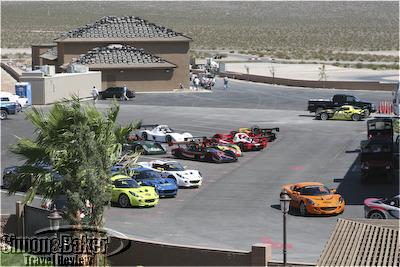
The view from the club tower
My plan was to spend the lion’s share of the day taking part in a professional Lotus driving course, and then return to Las Vegas for dinner and a show with my husband. I accomplished all my goals with room to spare although I was ready for some rest at the end of the evening. In spite of my lack of knowledge or experience with racing and race cars the staff welcomed me to the course.
After a brief classroom introduction we, a motley group of men, one other woman and I, were invited to select a car each to drive for the day. The club’s 15 Lotus cars are available for students and for rent. Minutes later we began our first breaking maneuvers. In the morning, we learned about wheel lockup, threshold breaking and conventional versus ABS (Anti-lock Breaking System) breaking systems. I was thrilled to be behind the wheel of my very own Lotus. It was mine to have and to hold, for better and for worse (I had promised to pay any expenses if I crashed or damaged the car), for the day.

The 2006 Lotus Elise I drove was a handsome vehicle with sexy lines, low to the ground with manual transmission (of course), seat belt, a two-way radio to communicate with my instructors, and air conditioning (only some cars had A/C). Although Proton, a Malaysian company, owns Lotus, the cars are still manufactured in Hethel, England.
Toward the middle of the day I discovered that the seat was designed for drivers 5’5” and taller. Because my height falls below that threshold, reaching the foot pedals (accelerator, break and clutch) required a little more effort than it should have, and made it especially difficult to practice some of the race track maneuvers like heel toe and foot positioning.
But I’m getting ahead of myself. Our first maneuvers were nerve wracking, and fun! Even some of the veteran race drivers confessed to being nervous. I thought it would become easier as we practiced more but there were usually only two practice rounds for each skill. After that we had to build on the new skill toward a more complex one. For those of us that didn’t master the skill the first two times learning a new skill on top of the old one we still didn’t master was frustrating.

Time in the classroom
Our instructors’, we had two instructors, philosophy was that the best way to learn to drive a race car was to do the exercise, then do it some more. Although there was a little classroom discussion most of our time was spent in the Lotus practicing maneuvers. By the end of the day, we were invited on to the race track where we practiced accelerating and braking at corners, heel toe, foot positioning, and had a couple of rounds with an instructor in the car before being allowed to “race” on the track.
The 1.5 mile race track at Club Spring Mountain Motorsports Country Club
With no racing experience I was definitely in the minority. Most of my fellow classmates had race cars of their own; at least one of them had a Lotus at home, or racing experience. Speed was they wanted. By the time we hit the race track most everyone was eager to spread their wings and see what the Lotus could do. It was sweet! I was the slowest driver so the instructors left me behind and dedicated their time to the rest of the drivers. A couple of times one of them shared audio feedback through the two-way radio and gave me instructions to get out of the way of the rest of the drivers that were coming through.

Some of Lotus cars in the Club Spring Mountain Motorsports Country Club
As I drove back to Las Vegas in the mid afternoon keeping the air conditioning cold to make sure I was awake (now that the adrenaline was slowing I was afraid I would get sleepy in the desert heat), I thought about my day’s adventure. I liked having an assigned car for the duration of the course. The club facilities were spacious, clean, inviting and luxurious. It was a pleasant place to spend the day and take a course. And, I loved the Lotus! It felt light and easy to handle. It drove well, hugging the road tightly and responding instantly.
At the end of the day and in spite of the many nervous moments during maneuvers, I walked away a better and more cautious driver for my efforts. If I ever have a chance to return or a friend asks for my recommendation, I would stay at a nearby hotel (rather than driving from Las Vegas), request a dedicated instructor so I can take my time and practice the skills until I’m comfortable, and take a two or three day course (one day was not enough). A course like that would be worth a dedicated trip to the Club Spring Mountain Motorsports Country Club and the subject of additional fond Lotus race car memories.
by Editor | Dec 1, 2008 | Accomodations, Books, Ecotourism, Restaurants, Spas

Red, White and Drunk All Over
The holiday season is upon us. For many people it’s a time of stress as well as joy and togetherness. Part of the stress comes from gift giving. Here are some gift ideas including books, gourmet dinners and exotic trips, we hope will help you narrow your choices and relieve some of the stress.
In Red, White and Drunk All Over, Natalie MacLean shares her love of wine and insights from an international wine oriented journey of discovery. The paperback edition, published last year, is 304 pages long and an easy read. At $14.95 Red, White and Drunk All Over is kind on the pocket and the well written book may be a good stocking stuffer for wine newbies and wine aficionados alike.

Cooks and cooking amateurs may appreciate the wealth of information in The Spice and Herb Bible (Robert Rose, $27.95). The exhaustive 607-page tome by Ian Hemphill includes detailed information about, well, herbs and spices.

Naughty Paris A Lady’s Guide to the Sexy City
Naughty Paris A Lady’s Guide to the Sexy City is for women who want to discover another side of Paris. According to the author, the City of Love offers ample opportunities for locals and visitors to indulge in the pleasures of the senses and love. In the 296-page well researched paperback book, Kristen Loop shares some of her ideas, findings and suggestions about love, romance, sexy hotels, outings, shopping, beauty options, culture, dancing, and shows in the romantic city.
A server shaves truffle bits over a dish at Ledoyen
While we’re on the subject of Paris, are you a foodie, celebrating a special occasion or just plain love dining in Paris? Do you have a healthy budget? How about a few days enjoying the best in gourmet dining available in the City of Lights? Of course you can try a neighborhood bistro but if you’re going all the way to Paris you probably want to indulge. Alain Ducasse and his Paris team at the Plaza Athenee Hotel are well known for their over the top dining. If you can’t get a table there or would rather be a tad more modest, other top tier choices include the dining rooms of: vegetable guru Alain Passard at Arpepe; Christian Le Squer at Ledoyen near the Champs Elysees, Helene Darroze at her restaurant in the Latin Quarter; Pierre Gagnaire’s Le Balzac; Pascal Barbot at L’Astrance, in the ritzy 16 arrondisement; Guy Martin’s historic Le Grand Vefour; and Guy Savoy at his eponymous establishment.
Dusk in Santa Fe
If North America is where you want to be on your next vacation, consider the Canadian Yukon, one of the last vast expanses of wilderness, for next summer; or one of the saints: San Diego and San Francisco in California or Santa Fe, New Mexico. Each one has its own charm. San Francisco, the most famous of the three, and the nearby wine country offer many options, accommodations, food and wine attractions within a short drive. San Diego, much further south and closer to the United States-Mexico border, is large and diverse with upscale and quaint seaside towns like La Jolla. Finally, Santa Fe, is a magnet for Pueblo style architecture and museum and art gallery lovers.
Male and female leopards “flirt” at Londolozi Tree Camp in South Africa
Do you long for something with a little more zest and adventure? If you are itching to travel, have the desire to see beautiful animals in their natural habitat, the patience to fly more than eight hours, and can afford world class accommodations, or as close to that as it gets in some remote areas, consider a safari trip to Africa. There are plentiful choices of destinations, properties, and game viewing options.
Many travelers in search of luxury lodge accommodations with gourmet dining, spa services and outstanding game viewing mention the Sabi Sand Reserve and the http://simonandbaker.com/kruger area in South Africa as favorites. Sabi Sand Reserve is home to Ivory Lodge and 1933 in Lion Sands, Tree Camp in Londolozi, Mala Mala Main Camp and Rattray’s in the Mala Mala Reserve, and Earth Lodge and Selati Camp in the Sabi Sabi Reserve. For a relaxing spa oriented visit our team liked the Cybele Forest Lodge and Health Spa near Kruger. The Outpost in the northern reaches of the park near the border with Zimbabwe offers game viewing in a serene off the beaten path setting.
Those seeking a wilder experience and willing to rough it, fly baby planes, stay in luxury tents and eat more modest meals can opt for other important African game destinations such as Botswana, Kenya, Tanzania, and Zambia depending on their interests, time and budget preferences. Botswana is known for its upscale orientation, huge elephant population and the famous Okavango Delta. Earlier this year, one of our teams enjoyed a visit to Mashatu in the Tuli Block of Botswana.
Areas to consider if visiting Tanzania include the Ruaha National Park, Selou Game Reserve, and Grumeti Game Reserve (adjacent to the Serengeti National Park). Visitors to Zambia may want to include one or more properties in Lower Zambezi National Park, South Luangwa National Park and Victoria Falls in their itinerary.
Whatever you do, we wish you a wonderful holiday season!



Click here to buy
Red, White, and Drunk All Over: A Wine-Soaked Journey from Grape to Glass
Naughty Paris: A Lady’s Guide to the Sexy City
The Spice and Herb Bible
by Editor | Sep 15, 2008 | Books

I Speak of Africa book cover
Leopard and wildlife lovers and fans of Londolozi Game Reserve near South Africa’s http://simonandbaker.com/kruger may enjoy I Speak of Africa (Londolozi Publishers), a hardcover book of the game reserve and its lodges as well as and its rich wildlife, including some of the leopards that have made the property famous. Filled with color photos on almost every page, the 216-page hardcover book written by Shan Varty and Molly Buchanan tells the story of Sparta as the original farm on the Sand River was called.
Eventually Sparta became a game viewing estate with luxury guest accommodation and was renamed Londolozi, meaning “the protector of all living things” in Zulu. In the book, Varty, a member of the founding family, and Buchanan, a public relations consultant specializing in wild life conservation, share the story of the evolution of land, and four generations of the family that owns it, from farm to hunting property to a world class safari destination.
The second edition of the book, published in 2007, includes a forward by former South African President Nelson Mandela. It is divided into eleven chapters: A Long Time Ago, The Pioneering Years, Wild Days, Hard Times, The Quest for Solutions, Close Encounters, Life at Londolozi, Widening Horizons, The Development of the Model, On the Wings of the Bateleur, and The End Is the Beginning. The majority of the photos, according to the credit list, were taken by Lex Hes. There are also photos by Peter Johnson (Corbis), Richard du Toit, Guy Stubbs, James Marshall, and Mike Myers as well as library photos.
Varty is director and publisher of I Speak of Africa, and a partner in Londolozi. Prior to writing the book, she lived with her family in the African Bush for a dozen years. During that time, she dedicated herself to the development of Londolozi as a top tier safari property with an emphasis on conservation. She was a founder director of Conservation Corporation.
Buchanan met Dave and Shan Varty in 1990 at the inception of Conservation Corporation. Following the meeting she began providing publicity support for their company. She has traveled extensively in sub-Saharan Africa and specialized her public relations business in the area of wilderness conservation. Buchanan, in partnership with Peter Johnson, also launched a publishing company.
Elena and Gary visited Londolozi Tree Camp for the first time this year. To learn about this newly rebuilt safari lodge, be on the look out for the upcoming dedicated feature in our http://simonandbaker.com/krugerpages.
Click here to buy I Speak of Africa – The Story of Londolozi Game Reserve
by Editor | Aug 18, 2008 | Books
 *
*
Mountain climbing enthusiast Duncan Souchon shares some of his passion for high places in Africa in the recently published Mountains of Africa (International Publishers Marketing,$29.95), a 191-page hardcover book. A combination of color photos, historical tidbits and quotes, the book transports armchair travelers, most of us unwilling or even unable to visit and climb the summit of these natural treasures, to the mythical heights of the Dark Continent.
Photos from 19 sources grace the pages of the book displaying the peaks and distinctive areas of 15 mountains: Table Mountain, The Ruwenzoris , Mont Cameroon, Kilimanjaro, Mount Meru, Namib Desert Peaks, The Ethiopian Highlands, Mount Kenya, Mount Elgon, The Atlas, Mulanje, Ol Doinyo Lengai, Virunga Volcanoes, Tsodilo Hills, and Ukhalamba-Drakensberg.
Souchon has sought peaks and adventure for the past 16 years. He has traveled across Africa and visited some of the continent’s highest mountains. His previous book, Serpent Spires, discussed mountaineering in the Ukhalamba-Drakensberg mountains.
*Photo: International Publishers Marketing

Click here to buy Mountains of Africa
by Editor | Jul 14, 2008 | Books, Restaurants
By Elena del Valle*
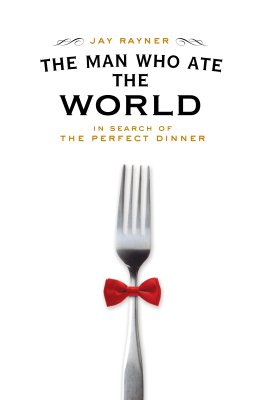
The Man Who Ate The World in Search of the Perfect Dinner book cover
Jay Rayner, a London restaurant critic, traveled across continents to enjoy a meal at the best fine dining establishments he could identify and shared his findings in a recently published 273-page paperback book, The Man Who Ate The World in Search of the Perfect Dinner (Henry Holt and Company, $25). It took him 18 months to complete his journey and write the book. His budget? $36,000.
He started at some famous restaurants in Las Vegas, Nevada and concluded his project at renown temples of fine dining in Paris, France. In between, he visited some of the most expensive restaurants in the world including well known and sometimes obscure restaurants in Moscow, Dubai, New York, Tokyo, and London. He dined out alone, with colleagues and friends and, in Paris, with his wife.

Jay Rayner, author and restaurant critic
He left ‘Vegas uncomfortable with the idea of being a guest of the restaurants and decided to pay his way as much as possible from that point forward. By the time he reached Paris he added one rule to his plan: he would order and eat the tasting menu whenever it was offered.
I found the book funny, interesting, and full of useful insights. While it is not a restaurant guidebook, there is a lot of information about gourmet restaurants and the business of fine dining. Filled with Rayner’s accounts of his dining experiences, The Man Who Ate The World is an armchair trip through the London critic’s eyes.
In the book, Rayner shares his impressions of the cities he visited, the culinary business world, some of the most celebrated gourmet chefs, his life as a paid restaurant critic for a British newspaper, the restaurants he visited, and some of the meals he was served. Although the promotional materials for the book never promised restaurant recommendations, more than once I wished he had shared practical suggestions or a summary with his recommendations.
Rayner is a restaurant critic for the London Observer where he has worked since 1996 and is on contract to write 100,000 words a year. Forty percent of the restaurants he writes about are in the fine dining category. In the United States, his articles have been published in Gourmet, Saveur and Food & Wine magazines. Prior to his work as a restaurant critic he covered crime, politics, cinema and theater. He is the author of five other books.
*Photos: Henry Holt and Company

Click here to buy The Man Who Ate the World


or




















 *
*









